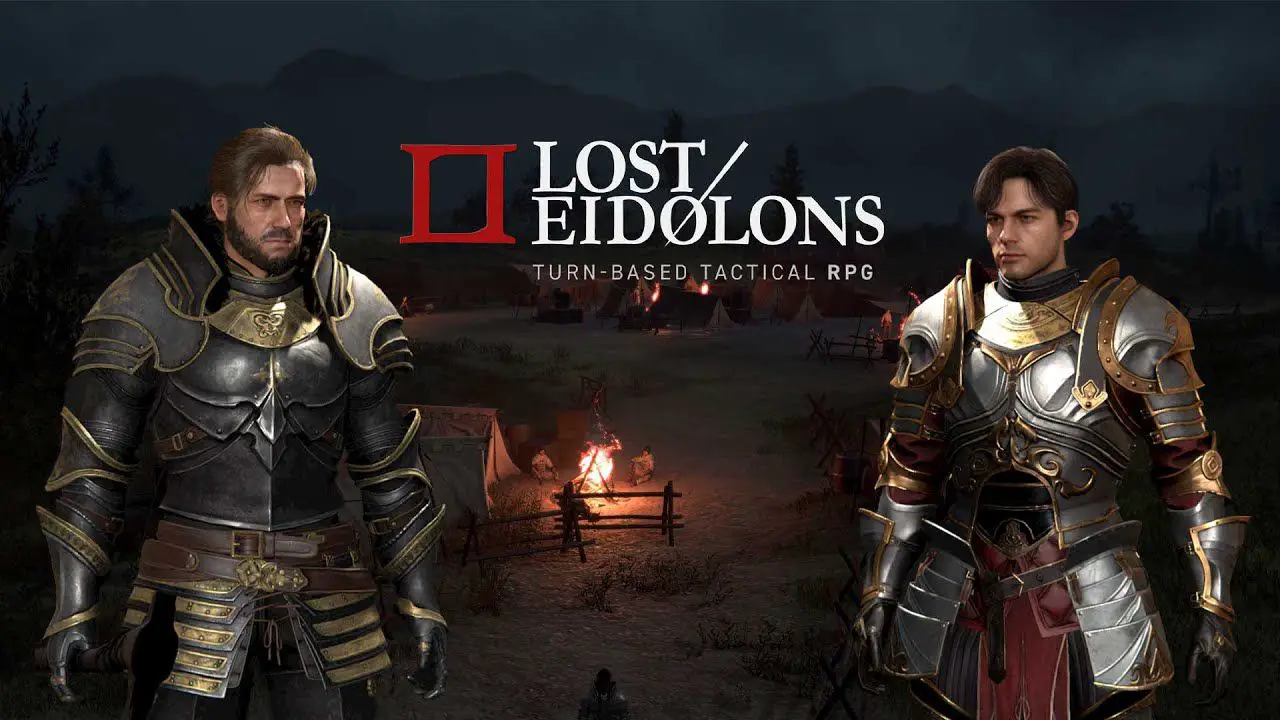Lost Eidolons by Ocean Drive Studio is a tactical turn-based strategy role-playing game (SRPG), where you play Eden, a mercenary captain in a small town at the corner of a crumbling Empire who is swept up in events causing both a meteoric rise and personal tragedy.
Overview
Lost Eidolons is structured around alternating 27 battle stages and camp stages, with the ability to play in optional battles periodically during the camp stages. The game is overall very linear, with very few story choices. Luckily the game is very dense on the strategic and tactical level, with plenty of interesting and ambiguous decisions about what characters to include in your party, which class to use with them, which weapons to train them with, which abilities you want to equip, which gear to equip, and even which other character to equip to the characters you are using in tactical situations.
The game’s tactical and gameplay structure is reminiscent of Fire Emblem in general and Fire Emblem: Three Houses in particular. It features alternating turns between the player and the opponent’s units, with an extra phase used for allied units. What a character can do on their turn depends on various factors with gear, class, and equipped abilities. However, with rare exceptions, all characters are limited to a single move and a single action per turn.
Characters, classes & skills
Characters start with one of two classes, neither of which has any mechanical impact, but further specialize as time goes on until you achieve a degree of maximum specialization once characters hit around level 30. Even with these more specialized classes, you have some flexibility in how you build them, and characters can mix and match abilities from various characters, for example, having a berserker with some bow skills. However, that generally seems to not be as strong as specialization.
Additionally, each character has two final tiers (Master) classes. They can get a character-specific ability if they max out their class experience, with these abilities remaining present regardless of the class they are in. This encourages you to try out different classes with your main team even into the end game and ensures that even if you have two characters of the same class, they will end up with unique identities.
The three different types of magicians (elemental, dark, and light) are customized further by being able to select a subset from about twelve different spells to bring to battles. Elemental spells are mostly focused on direct damage and taking advantage of the water and forests in the environment, dark spells are a mixture of damage and status effects, and light magic is mostly focused on healing and status removal. Characters cannot mix spell types, but some late-game classes combine physical capabilities and magic, leading to some fun decisions about what side of things you want to lean toward to truly optimize the character’s role in battle.
Characters develop primarily through class progression and skill progression. Classes have level, chapter, and skill requirements, though the chapter requirements usually correspond roughly to when your characters reach those levels. Skill progression provides passives related to the weapon, magic type, armor, or mount you are using, with increased levels in the skill unlocking increasingly better passives that you can equip. Classes provide core abilities that can’t be transferred to other classes and learned abilities that compete for the same spots that the skills needed.
While this review will not cover every single mechanical feature of Lost Eidolons beyond saying that they are largely well-designed and clearly show that Ocean Drive Studio was thinking deeply about how to make the game and each mechanic’s place in the game, the Aide system is interesting and different enough to be worth describing. Essentially, it allows a given character to equip another one.
Aide System
The Aide system gives the equipping character the aide character’s specific passive ability and a second passive ability that depends on the aide character’s class. The aide characters benefit from continuing to gain class, gear, and level experience, helping to ensure that they don’t fall too far behind.
This system unlocks an explosion of build complexity in Lost Eidolons. It opens up the potential for building niche characters to use in certain situations and levels without necessarily punishing you or leaving you without the resources to build more straightforward characters.
Monster Battle System
The other particular stand-out feature is the monster battle system. Monsters have unique capabilities that deviate from those displayed by the normal fights with other humans that share the same class system and serve as a nice change of pace from normal fights. They also are built around a combo system, where if you hit them in the right spot with the right attack type, you do normal damage and build up combo damage. Still, if you don’t, then you do a fraction of your normal damage, with none of the weapon vs. armor bonuses you will get in a normal fight.
The pure monster fights are largely fun, and a nice change of pace, and the rare instances where you have to fight a mixture of monsters and human opponents are among the most interesting battles in the entire game.
Achievements and Successes
Frankly, I am not normally a fan of Fire Emblem-style games. I quite like having deep, and expansive character builds with interesting decisions that continue right up to the point the game ends, and for the most part, Fire Emblem-style games fail to achieve this. Lost Eidolons does.
There is a great deal of ambiguity over what mixture of classes is the best, which combination of characters and aides you want to use, and which combination of gear and weapon skills you want to equip. This leads to a fun decision space that is accentuated by the fact that even the hardest difficulty won’t be too difficult for tactics fans, leaving space to try out new builds and combinations while still being reasonably challenged.
Outside of that space, everything else feels tight and well-designed. Basically, any user interface feature I could reasonably want and expect is available; individual units and all enemy threat ranges are easily accessible, ability descriptions are present and (mostly) clear, and the game allows for common sense rewinds before an action occurs.
Additionally, the game features an actual undo mechanic that lets you use up a battle resource to return to any earlier point in a battle and replay from that point. If you mess up enough, you will be forced to restart. Still, if you just make a small mistake or want to reconsider how to approach a tactical situation, you can without going through the tedium of playing through the battle exactly to that point again. This feels respectful of the player’s time and is greatly appreciated.
The story is serviceable. It does not match some of the games that are specifically built around storytelling, but I never really expected it to. I hoped that it would provide me with an effective and engaging context for the in-depth tactical battles without insulting my intelligence or making me resent the characters for their one-dimensionality or stupidity, and it succeeded in doing that.
I even found it interesting enough that I largely watched and listened to all of the individual character builds in most other games too dull for me to bother even sitting through. In the rare cases where I found my interest dragging or had to go through the same thing again due to a reload, the game provides easy features to skip through almost any scene.
Limitations and Failures
Overall, I am quite pleased with Lost Eidolons and consider it a success, that doesn’t mean it is perfect, though. While the game is quite good at avoiding tedium and unfair situations, I feel that two of the game’s subsystems fail in the tedium test, and one stage, in particular, fails the unfairness test.
The first system that doesn’t live up to the game’s overall quality is the prestige system, The prestige system essentially requires you to do camp side quests in exchange for periodically getting bonus gear or money and even less frequent increases in the number of resources you have for relationship building. Unfortunately, these prestige quests are inevitably dull and, unlike most camp quests, don’t even show up in your quest log, forcing you to come back to the prestige quest board to find out what exact inane fetch quest you need to perform to get your reward.
The second tedious system is the optional battles. While the battles for the main campaign are interesting and excellent at providing varying challenges, the optional battles are repetitive, dull, and great at providing you with the same set of three challenges over and over again. These optional side battles feel important from character development, goal, and testing perspective, but Ocean Drive Studio really should have spent more time with them before release.
The main stages are mostly great, providing interesting challenges to conquer and consider without feeling like they directly challenge the assumption of fairness established in stages before this point. In one stage, you are given a special goal that requires one of your characters to sneak independently across the board to generate some allied units to serve as a distraction while your main party sneaks through the side of the castle.
On the harder difficulties, these distraction units and the character you send will die, and with permadeath, this means by following the established and encouraging structure of the stage, you will have to sacrifice a character. This is not required, but the stage becomes considerably more difficult if you do not do it, and it flies in the face of logic that going for the assumed optimal route results in a worse outcome for you.
The game also suffers a bit from its lack of use of monsters. Their presence drops off dramatically in the later part of the game, with the promise of their use in combination with regular human opponents never really paying off. I am sure the disuse was in service of the story, but from a tactical perspective, I think the game would be even better if they were used more often.
Conclusion
Lost Eidolons is a very good SRPG and one that I can highly recommend to any fan of the genre. It combines good graphics, excellent UI, deep and engaging battles and systems, and real and interesting decisions for character builds and team compositions. While it is not perfect, the things that it does wrong are so vastly outweighed by the things that it does right that it stands out as one of the best tactical games released in a year that is already dense with good ones. Buy it, play it, and enjoy it.







